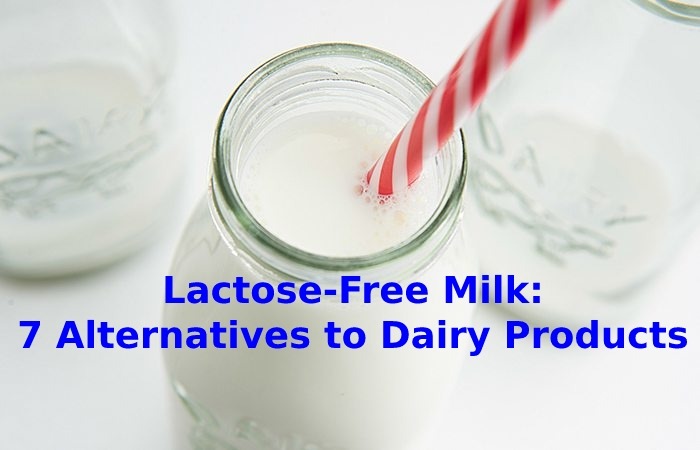Lactose-Free Milk – People with lactose intolerance are now happy with the large selection of lactose-free dairy products. In recent years, the range has indeed grown more and more, and that’s great! But do you know how lactose-free milk is made?
If you are lactose intolerant, lactose-free milk is definitely for you.
What are the characteristics of lactose-free milk? Who is it recommended for? What are its benefits? We will give you all the answers to your questions in our article.
Characteristics of Lactose-Free Milk
Milk naturally contains a special sugar called “lactose.” However, the body must secrete lactase’s specific enzyme to digest lactose. It allows lactose to separate into two distinct molecules: galactose and glucose.
Lactose-Free milk is therefore
- either milk from which lactose has been eliminated;
- or milk in which lactase has ads that release galactose and glucose into the milk: these molecules, then absorbed by the lactose intolerant person, allow the milk to digest without difficulty.
Milk to which lactase has been added can be used like any other milk, cold or hot.
Good to know: lactose-free milk can be consumed or added to culinary recipes (sauces, desserts, etc.). It supports cooking perfectly.
Lactose-free Milk – For Whom?
Lactose-free milk is suitable for people with varying degrees of lactose intolerance, representing roughly 75% of the population worldwide, adults in the vast majority of cases. It is ultimately quite logical since the human body (except during the first months of life) does not produce enough lactase to digest cow’s milk.
Lactose-free milk is ideal in these cases because it allows people with lactose intolerance to continue consuming milk and benefit from its health benefits.
However, it is main to make sure that you are intolerant to lactose. The digestive discomfort that occurs after ingesting cow’s milk can be due to anything else, for example, an allergy to casein. To be sure, drink goat’s milk since it contains lactose but no casein. If the symptoms disappear, it is a casein allergy and not lactose intolerance.
Good to know: lactose intolerance should not be confused with an allergy to cow’s milk proteins, and the latter mainly concerns very young children due to a disruption of the immune system. If in doubt, do not hesitate to consult your doctor.
Benefits of Lactose-Free Milk
Lactose-free milk is just as beneficial for your health as non-lactose-free milk:
- It retains its nutritional qualities.
- It is very digestible.
- However, it consents people who are lactose intolerant to free themselves from many symptoms related to this intolerance, namely: gas, intestinal spasms, diarrhea.
- It can remain consumed daily, either plain or introduced to many recipes.
Good to know: if you are lactose intolerant, check the composition of the industrial products you buy. Many of them contain milk, lactose, and do not hesitate to replace them with homemade products with lactose-free milk.
Lactose-Free Milk: 7 Alternatives to Dairy Products
Nutritionally, lactose-free products are not necessarily better for your health, especially if you take added sugars into account. “People who do not consume dairy products must be cautious about the composition of the food they buy,” underlines the dietician.
Soy Milk
Soy milk is probably the best known and most widely used of all the available alternatives. “It is not milk, but a liquid made from soybean germ. As it does not contain lactose, it is often recommended for people who have an intolerance.” Drs specifies that soy milk is the only daily alternative recommended by the Canadian Department of Health. “Compared to other kinds of milk, its nutrient profile most closely matches that of cow’s milk.” Soymilk is a good source of protein, and most soy products contain supplements of calcium, riboflavin, and vitamins A, D, and B12.
Rice Milk
Rice milk is made with boiled rice, rice syrup, and brown rice flour, and it generally tastes better than cow’s milk. “Compared to dairy products and soy milk, rice milk contains much less protein (just 1g) and very little calcium,” says Drs. Most brands add calcium and vitamins A, D, and B12. Please read the label carefully before buying it.
Almond Milk
Another popular alternative crushes almonds, water, and a light sweetener. “Eating a handful of almonds is, of course, very high in calories, but almond milk is much less wealthy, and people often amazed to learn that it contains very little protein and almost no vitamin. B. ” If you are looking to reap the energy benefits of consuming almonds, then it is best to eat a handful. And if you love to cook, Drs recommends almond milk or coconut milk because of its sweet taste.
Potato Milk
Yes, yes, it does exist. “Potato milk is one of the newer alternatives. So it’s harder to find than soy or rice milk.” Like the latter, potato milk contains a lot of carbohydrates but little protein.
Hemp Milk
Usually made with hulls of hemp seeds, water, and a sweetener, hemp milk contains more protein and omega-3s than others but no calcium.
Oat Milk
Oat milk made with oatmeal, water, other grains, beans, barley, brown rice, and bean sprouts. It is mild and slightly sweet, making it an ideal substitute for skimmed or semi-skimmed milk. “As with other herbal drinks, watch out for supplements, and I also recommend against people with gluten intolerance.”


